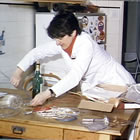
Angioplasty balloon being manufactured on the kitchen table in Gruentzig’s apartment
Today marks the 39th anniversary of the first percutaneous transluminal coronary angioplasty (PTCA) which was performed in 1977 by Dr. Andreas R. Gruentzig in Zurich, Switzerland. This angioplasty procedure utilized an expandable balloon, fashioned on a kitchen table in Gruentzig’s apartment by Gruentzig’s assistant, Maria Schlumpf (note the bottle of wine…and yes, she used Krazy Glue). So, as I always ruefully think about on my own birthday, one is actually celebrating the completion of that numeric year, and sometime later today, coronary angioplasty will be entering its 40th year. Kind of amazing.
While we’re on the subject of numbers, the first patient was 37-year-old Adolph Bachman, the same age as Gruentzig himself. Bachman had been admitted to University Hospital with severe angina. Had a focal stenosis in his mid-proximal LAD and was scheduled for bypass surgery. Gruentzig has been working on his idea for several years; it was an idea first germinated by a U.S. radiologist, Dr. Charles Dotter, in the early 60’s. Dotter in fact coined the term “angioplasty” to describe opening up a blocked artery in the leg, not through open surgery, but by threading a catheter into the artery and opening it up from the inside out: less traumatic, quicker, and possibly (he thought) more durable.
Dotter’s idea was mocked as crazy (he became known as “Crazy Charlie”) by the surgical community of the day and it took years for Dotter’s concept to travel across the world to Europe, where Gruentzig learned about it. Dotter’s technique was to insert increasingly larger diameter catheters and push open the soft plaque causing the blockage. This worked somewhat in the long, straight arteries in the leg, but obviously couldn’t be utilized in the curvy, sometimes tortuous coronary arteries. So Gruentzig added a balloon to the tip of the catheter and, after experimenting in the lab in Zurich, he teamed up with Dr. Richard K. Myler of San Francisco to try the idea intraoperatively in patients who were having open heart surgery.
When the concept had been proven in a few of these surgical cases, Gruentzig returned to Zurich to attempt doing an angioplasty in the cath lab without surgery: percutaneously – just through a needle stick, the same basic procedure as a diagnostic angiogram. Except with a balloon. That’s where our video below begins: the story of the first angioplasty.
(By the way, the clip below is excerpted from my feature-length award-winning documentary, “PTCA: A History,” which tells the whole tale of how this “crazy” idea turned into a major branch of modern medicine. The complete 72 minute DVD is available for sale on our web site — of course!)
Although the speakers are ID’d in the clip, they are, as follows: Bernhard Meier, MD, FACC, Chair of the Swiss Cardiovascular Center, University Hospital in Bern, Switzerland; Maria Schlumpf, who was Andreas Gruentzig’s assistant in Zurich, until he moved to Emory University Hospital in 1980; Adolph Bachman, the first angioplasty patient, who still lives in Switzerland; John E. Abele, retired Founder Chairman of Boston Scientific who has been involved in many educational and organizational efforts regarding technology and its impact on our lives – our documentary from which this clip is excerpted was made possible by an educational grant from him.
The full-length documentary includes many others who were part of the story of angioplasty. My goal in making that video was to not have a “narrator”, and I don’t. The story is told entirely in the first person by the doctors and healthcare professionals who were there! Among them are: David Auth, Joe Brown, Heliane Canepa, William Casarella MD, Andreas R. Gruentzig MD, Geoffrey O. Hartzler MD, J. Willis Hurst MD, Spencer B. King III MD, Martin B. Leon MD, Richard K. Myler MD, Richard Schatz MD, Patrick W. Serruys MD, Paul Yock MD, Eberhard Zeitler MD and more….
Happy birthday angioplasty and…did I mention that you can purchase the full-length documentary here?
(The above post was adapted from an earlier article, published on September 16, 2012)




Dr. Gruentzig was the first to do PTCA but the procedure would not be what it is today without the work of Geoff Hartzler, his colleagues, and technical staff at the Mid-America Heart Institute in Kansas City from 1980-1995.
Paul – Absolutely. And there are so many pioneers who contributed to PTCA and helped make it what it is today. Many of them, including Geoff, are in my award-winning documentary, PTCA: A History.” Part of this was because Gruentzig practiced what today is known as “open source.” He taught everyone everything he knew so that they could move forward in all directions. Of course, Geoff Hartzler performed the first PTCA in a patient having a heart attack (STEMI) which today has become the most important and undisputed benefit of angioplasty. To hear him tell the story, read my blog “Geoff Hartzler, Angioplasty Pioneer: In Memoriam“